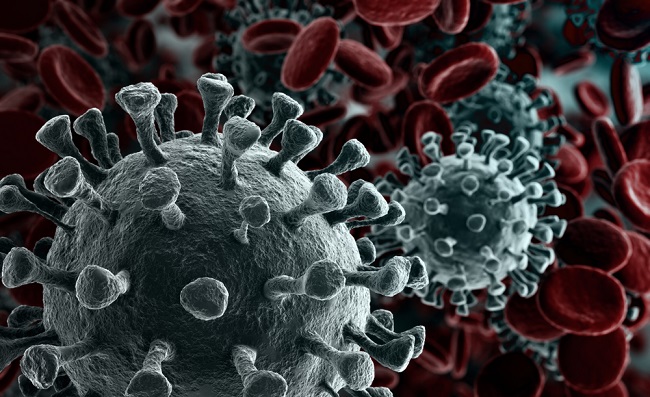Complex evolutionary history of SARS-related coronaviruses disentangled
Published: 9 February 2022
New research has disentangled the complex evolutionary history of bat coronaviruses related to SARS-CoV-2, the virus responsible for COVID-19
New research has disentangled the complex evolutionary history of bat coronaviruses related to SARS-CoV-2, the virus responsible for COVID-19.
Scientists agree that bats are the most likely animal host species of SARS-CoV-2 viral ancestors, however no one has yet been able to fully explain the virus’s history or pinpoint the animal species that ultimately passed the new coronavirus to humans.
Now, in a new study led by the MRC-University of Glasgow Centre for Virus Research in collaboration with a team of international scientists, researchers have been able to find out more than ever before about the evolutionary history of SARS-CoV-2, unambiguously tracing the virus origins to horseshoe bats. The new study is published in Genome Biology and Evolution.

This latest research takes a look at the viral evolution of the SARS-related coronaviruses by investigating the evolutionary history of co-circulating bat coronaviruses and the phenomenon of virus recombination – when a host bat is infected with two coronaviruses at once and the viruses swap bits of their genetic material inside host cells to create a new, 'recombinant' virus. Recombination is common, and the process is used by many viruses, including coronaviruses, to generate novel genome forms, which contribute to virus adaptation and persistence.
The study demonstrates how vital it is to take recombination into account, by looking at the past evolutionary history of these SARS-related coronaviruses. As an example, the researchers confirmed that the RaTG13 bat virus, which is often described as the on-average closest virus to SARS-CoV-2, is not in fact the evolutionary closest virus once recombination history is taken into account in the other SARS-related coronaviruses. These findings mean that the closest ancestor of SARS-CoV-2 could be distributed over a large geographic area, and is not necessarily from Yunnan, China, as is often currently assumed.
Spyros Lytras, first author of the study said: “Recombination is a mechanism seen in many viruses, where related viruses can swap bits of their genetic material when they find themselves infecting the same cell, resulting in a new mosaic virus. It is clear that recombination is a defining feature of SARS-related coronaviruses and essential to account for when examining the viruses’ evolution.”
SARS-related coronaviruses, which includes SARS-CoV-2, are dispersed over a large geographical area across China and Southeast Asia. Since the 2020 coronavirus pandemic began scientists have uncovered a number of viruses related to SARS-CoV-2, retrieved from locations in China and Southeast Asia. However, none of these viruses are that close to the SARS-CoV-2 progenitor, only sharing a common ancestor several decades ago. Importantly, several of these viruses related to SARS-CoV-2 are known to be recombinant viruses, suggesting the virus responsible for COVID-19 does not have one single and simple evolutionary line.
This new research analysed a wide distribution of related viruses in bats, with shared markers of viral recombination (specific points in the virus’s genetic material, or RNA) suggesting that SARS-CoV-2 ancestors were frequently transmitting amongst bats species, with the virus changing and recombining over time as host bats were infected with two coronaviruses at once. Professor David L Robertson, senior author on the study said: “Worryingly this indicates there is undoubtedly a virus highly related to SARS-CoV-2 still present somewhere in the wild in China.”
This study shows that there have been many recombination events in SARS-related coronaviruses from which SARS-CoV-2 emerged, taking place in the past few centuries across an extensive geographic area of at least 2,500km. The researchers agree that more work needs to be done to pinpoint closer relatives of SARS-CoV-2 by increasing virus sampling in wildlife.
David L Robertson added: “Our analysis highlights the need for dramatically more wildlife sampling to pinpoint the exact origins of SARS-CoV-2 and understood more fully the risk of infection of humans by viruses like these across China and Southeast Asia. The finding of bat coronaviruses that can so readily use the human – and other mammals – ACE2 receptor without having to undergo any significant evolutionary change underscores the inevitability of future spill overs.”
The paper ‘Exploring the natural origins of SARS-CoV-2 in the light of recombination’ is published in Genome Biology and Evolution. The work was funded by the Medical Research Council (MRC) and the Wellcome Trust.
Enquiries: ali.howard@glasgow.ac.uk or elizabeth.mcmeekin@glasgow.ac.uk / 0141 330 6557 or 0141 330 4831
First published: 9 February 2022
<< February
Related Links
- Professor David Robertson, profile
- MRC-University of Glasgow Centre for Virus Research
- Institute of Infection, Immunity and Inflammation
- College of Medical, Veterinary and Life Sciences
- The Medical Reserch Council (MRC)
- Wellcome
- 'Exploring the natural origins of SARS-CoV-2 in the light of recombination’ published in Genome Biology and Evolution

